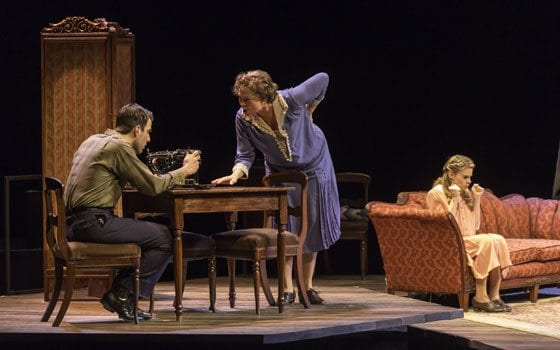
The classic Tennessee Williams play “The Glass Menagerie,” an ode to the nurturing and constricting power of family, is rendered with aching beauty in a new production at the American Repertory Theater in Harvard Square through March 17th.
In 1943, Williams wrote a semi-autobiographical short story, “Portrait of a Girl in Glass,” and turned it into a play. Soon after its December 1944 debut in Chicago, “The Glass Menagerie” began a Broadway run that lasted more than a year and won a Tony Award. The play launched the Williams’ career; his other great plays include “A Streetcar Named Desire” and “Cat on a Hot Tin Roof. ”
Directed by John Tiffany, this production is true to the intentions of the playwright. With staging as poetic as his language, the characters can work their magic.
Loosely based on the author’s own family, Amanda Wingfield and her grown children Tom and Laura could easily be caricatures in a lesser production. Here, we see them as the playwright does, with their humanity as well as their excesses intact.
A Southern belle whose husband abandoned her, Amanda has singlehandedly raised her two children during the Depression. Now Tom, her principal breadwinner, is on the verge of taking off too, stifled by his warehouse job. Laura is a fragile girl who retreats from life, preferring to play old records and contemplate her miniature glass animals.
Tiffany staged the play with the same team that helped him develop the Broadway musical “Once,” which won eight 2012 Tony Awards, including set and costume designer Bob Crowley, lighting designer Natasha Katz, sound designer Clive Goodwin and movement choreographer Steven Hoggett.
Laden with images of extinction, from Laura’s glass unicorn to Amanda’s chiffon ball gown, the play’s lyrical language conjures the emotional truth of its four characters.
Visual surprises abound in this magical set. Characters emerge as if summoned by thought only to disappear when one episode dissolves into another. Surrounding the stage like a moat is a watery surface that suggests the reflecting and distorting properties of glass — and of memory. Few objects clutter the Wingfield apartment, which is furnished with a vintage sofa, a folding screen, a table, a pentagon-shaped carpet, Laura’s Victrola and cabinet, and Tom’s typewriter.
Heightening the dreamlike quality of some scenes is delicate piano and fiddle music by Nico Muhly and agile, atmospheric lighting that can pinpoint a tiny glass unicorn, suggest the reflecting lanterns in the dancehall next door or highlight the shoulders of actors in a darkening room. Standing in a pool of light in a white shirt, a candleholder in hand, Tom looks like a ghost.
All this stagecraft serves the splendid four-member cast, who plumb the chasm between Amanda Wingfield and the people around her — the source of the play’s humor, tension and tragedy.
As portrayed by multiple-Tony Award winner Cherry Jones, beneath her ambition, desperation and delusions, Amanda is also a heroic figure. Clinging to the vestiges of her girlhood as a Southern coquette, Amanda is now a matron selling magazine subscriptions to survive and a mother desperately trying to secure a future for her helpless daughter. In one scene, Amanda wears the crisp white lace collar of a determined matriarch. In another, she dons the ball gown of a faded Southern belle.
Her defenses against an unbearable reality are her fierce resourcefulness, jonquil-scented memories and a nonstop barrage of words, including her oft-told tale of entertaining 17 “gentleman callers” in a single day.
She nags Tom to sit up straight, chew his food, stop smoking and above all, to bring home a gentleman caller for Laura.
Zachary Quinto is a convincing Tom Wingfield, despite an overly broad Southern accent. Quinto conveys both his character’s rage and sardonic humor. He also has a light touch as he teasingly lets his mother know that indeed, a gentleman caller is coming.
Although she is as fragile as her glass figurines, Laura Wingfield, like her brother, sees things as they are. Celia Keenan-Bolger is compelling as a delicate but sturdily self-contained Laura. She quietly holds her own against her volcanic mother.
Also ideally cast is Brian J. Smith as the Gentleman Caller. He exudes the wholesome charm of a young man on good terms with life. He and Keenan-Bolger achieve real chemistry when they are alone together. Laura undergoes a poignant transformation as she relaxes with the Gentleman Caller.
Yet happiness is fleeting in the Wingfield household, where, says Tom, the Gentleman Caller represents “the long-delayed but always expected something that we live for.”






